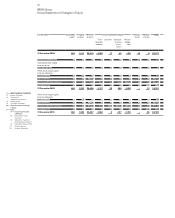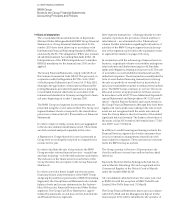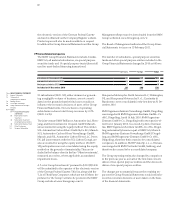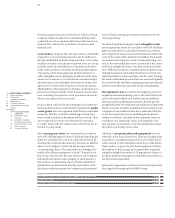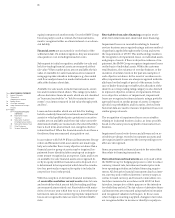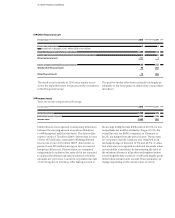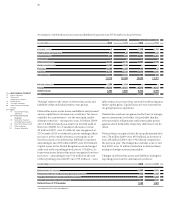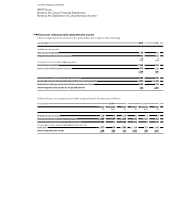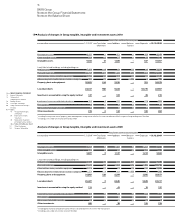BMW 2010 Annual Report Download - page 88
Download and view the complete annual report
Please find page 88 of the 2010 BMW annual report below. You can navigate through the pages in the report by either clicking on the pages listed below, or by using the keyword search tool below to find specific information within the annual report.
86
74 GROUP FINANCIAL STATEMENTS
74 Income Statements
74 Statement of
Comprehensive Income
76 Balance Sheets
78 Cash Flow Statements
80 Group Statement of Changes
in Equity
81 Notes
81 Accounting Principles
and Policies
89 Notes to the Income
Statement
95 Notes to the Statement
of Comprehensive Income
96 Notes to the Balance Sheet
117 Other Disclosures
133 Segment Information
equity instrument of another entity. Once the BMW Group
becomes party to such a contract, the financial instru-
ment is recognised either as a financial asset or as a finan-
cial liability.
Financial assets are accounted for on the basis of the
settlement date. On initial recognition, they are measured
at acquisition cost, including transaction costs.
Subsequent to initial recognition, available-for-sale and
held-for-trading financial assets are measured at their
fair value. When market prices are not available, the fair
value of available-for-sale financial assets is measured
using appropriate valuation techniques e.g. discounted
cash flow analysis based on market information avail-
able at the balance sheet date.
Available-for-sale assets include financial assets, securi-
ties and investment fund shares. This category includes
all non-derivative financial assets which are not classified
as “loans and receivables” or “held-to-maturity invest-
ments” or as items measured “at fair value through profit
and loss”.
Loans and receivables which are not held for trading,
held-to-maturity financial investments and all financial
assets for which published price quotations in an active
market are not available and whose fair value cannot be
determined reliably, are measured, to the extent that they
have a fixed term, at amortised cost, using the effective
interest method. When the financial assets do not have a
fixed term, they are measured at acquisition cost.
In accordance with IAS 39 (Financial Instruments: Recog-
nition and Measurement), assessments are made regu-
larly as to whether there is any objective evidence that a
financial asset or group of assets may be impaired. Im-
pairment losses identified after carrying out an impair-
ment test are recognised as an expense. Gains and losses
on available-for-sale financial assets are recognised di-
rectly in equity until the financial asset is disposed of or
is determined to be impaired, at which time the cumula-
tive loss previously recognised in equity is included in
net profit or loss for the period.
With the exception of derivative financial instruments,
all receivables and other current assets relate to loans
and receivables which are not held for trading and they
are measured at amortised cost. Receivables with matu-
rities
of over one year which bear no or a lower-than-mar-
ket
interest rate are discounted. Appropriate impairment
losses are recognised to take account of all identifiable
risks.
Receivables from sales financing comprise receiv-
ables
from retail customer, dealer and lease financing.
Impairment losses on receivables relating to financial
services business are recognised using a uniform method-
ology that is applied throughout the Group and meets
the requirements of IAS 39. This methodology results in
the recognition of impairment losses on individual assets
and groups of assets. If there is objective evidence of im-
pairment, the BMW Group recognises impairment losses
on the basis of individual assets. Within the customer
retail business, the existence of overdue balances or the
incidence of similar events in the past are examples of
such objective evidence. In the event of overdue receiv-
ables, impairment losses are always recognised individu-
ally based on the length of period of the arrears. In the
case of dealer financing receivables, the allocation of the
dealer to a corresponding rating category is also deemed
to represent objective evidence of impairment. If there
isno objective evidence of impairment, impairment
losses are recognised on financial assets using a portfolio
approach based on similar groups of assets. Company-
specific loss probabilities and loss ratios, derived from
historical data, are used to measure impairment losses on
similar groups of assets.
The recognition of impairment losses on receivables
relating to industrial business is also, as far as possible,
based on the same process applied to financial services
business.
Impairment losses (write-downs and allowances) on re-
ceivables are always recorded on separate accounts and
derecognised at the same time the corresponding receiv-
ables are dercognised.
Items are presented as financial assets to the extent that
they relate to financing transactions.
Derivative financial instruments are only used within
the BMW Group for hedging purposes in order to reduce
currency, interest rate, fair value and market price risks
from operating activities and related financing require-
ments. All derivative financial instruments (such as inter-
est, currency and combined interest /currency swaps as
well as forward currency and forward commodities con-
tracts) are measured in accordance with IAS 39 at their
fair value, irrespective of their purpose or the intention
for which they are held. The fair values of derivative finan-
cial instruments are measured using market information
and recognised valuation techniques. In those cases
where hedge accounting is applied, changes in fair value
are recognised either in income or directly in equity un-






